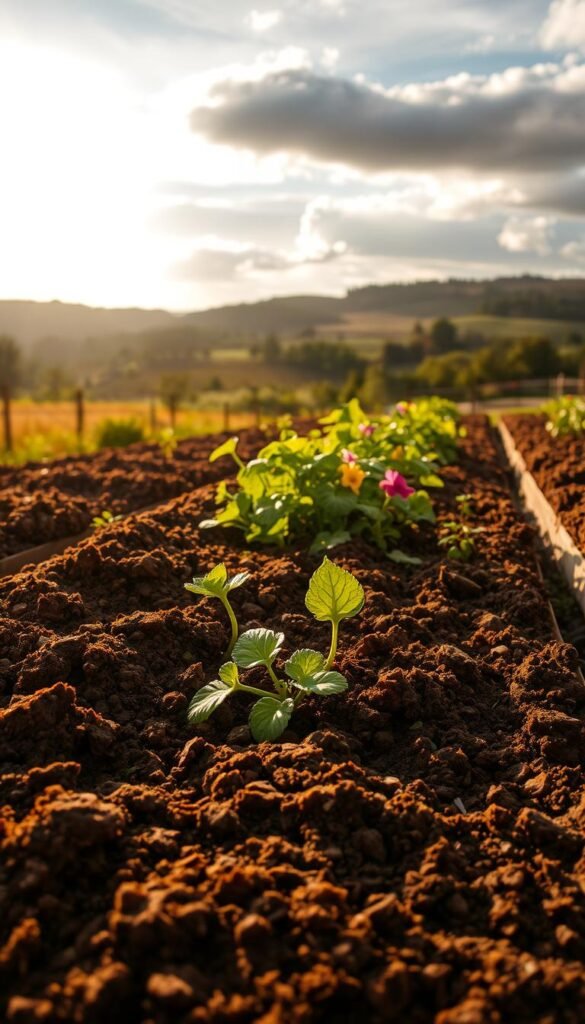Growing plants in elevated spaces comes with unique benefits—and challenges. Unlike traditional plots, these structures warm faster in spring and improve drainage. But without the right mix of organic matter and minerals, your plants won’t thrive.
Studies show a 40-50% increase in harvests when using proper techniques. The secret? Balancing compost, aeration materials, and pH levels. Most vegetables prefer slightly acidic conditions (6.0–7.0), while crops like blueberries need more acidity.
Our soil preparation guide explains how a 1-1-1 blend (compost, topsoil, and vermiculite) creates ideal texture. Aim for 12–18″ depth to support strong roots. Annual adjustments can lift productivity by 15–20%.
Ready to transform your garden? Let’s explore the best ways to enrich your growing space.
Why Raised Bed Soil Needs Special Attention
Elevated gardens require careful soil management to unlock their full potential. Their confined space and exposure create unique growing conditions. Without adjustments, plants may struggle despite the benefits.
The unique challenges of confined growing spaces
Nutrients wash out 30% faster in raised beds than in ground plots. This happens because water drains quickly through the loose, aerated mix. Frequent feeding or slow-release amendments help combat this.
Compaction is another issue. In beds wider than 4 feet, stepping near edges presses down the growing medium. Roots then struggle to spread, cutting yields by up to 40% over three years.
How elevated beds change soil behavior
These structures warm 2–3 weeks earlier in spring, speeding up planting. But heat also increases evaporation—moisture loss is 25% higher than in-ground gardens. Mulching helps retain water.
Biochar can boost water retention by 20–30%, studies show. It’s one way to balance the faster drying rate. Drip irrigation systems also reduce water use by 60% compared to sprinklers.
| Factor | Ground Soil | Raised Beds |
|---|---|---|
| Drainage | Moderate | High |
| Root Depth | Unlimited | 12–18″ (limited by frame) |
| Space Efficiency | 100 sq ft traditional | 80% more productive |
Deep-rooted crops like carrots need extra depth. Aim for at least 1 cubic yard of mix per 4×8-foot bed. This ensures enough room for strong growth.
Compost: The Foundation of Healthy Raised Bed Soil
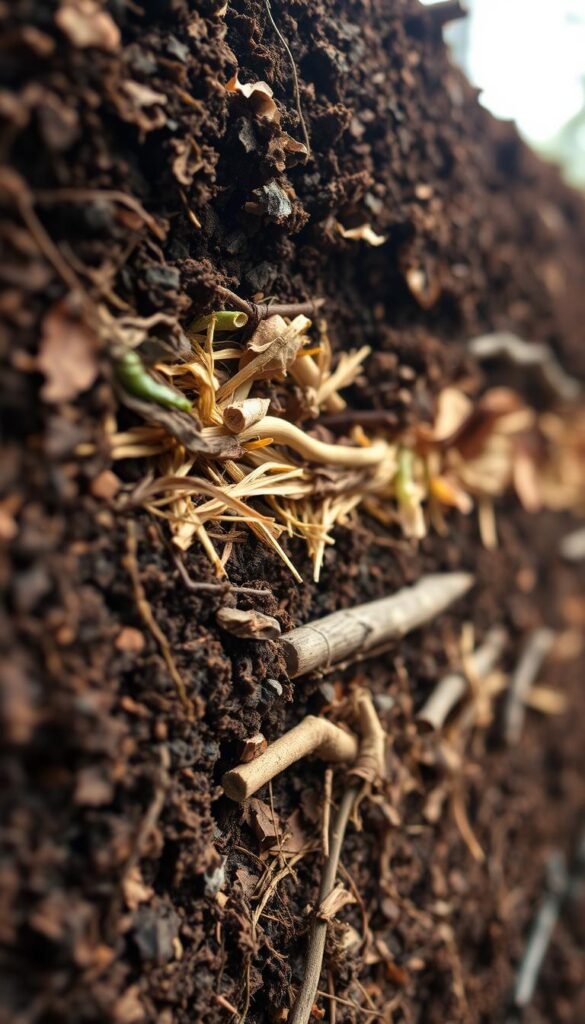
Your garden’s success starts with what you put beneath your plants. Compost isn’t just decayed waste—it’s a powerhouse of nutrients and microbes that fuel growth. Studies show it can increase water retention by 40%, making it essential for elevated gardens.
Nutrient profiles of different compost types
Not all compost is equal. Vermicompost (worm castings) packs a 5-3-2 NPK ratio, ideal for gentle feeding. Mushroom compost, at 1-1-1, adds minerals but less nitrogen. For balanced soil health, mix both or choose based on crop needs.
Top compost sources include:
- Leaf mold (slow-release calcium)
- Aged manure (high nitrogen)
- Food scraps (diverse micronutrients)
“Fresh compost can burn roots—always age it for 3–6 months.”
How to layer compost for maximum benefit
Add 2 inches of compost before each planting cycle. This mimics nature’s nutrient cycle. For faster breakdown, alternate greens (food scraps) and browns (dry leaves) in a 50/50 mix.
Pair compost with biochar to lock in nutrients. One gardener reported a 200% yield increase after using compost tea weekly. The recipe? Steep finished compost in water for 48 hours, then apply.
With these steps, you’ll improve soil structure and fertility—naturally.
Vermiculite: The Moisture Manager
The right mineral can transform how your garden holds water. Vermiculite, a natural silicate, acts like a sponge—absorbing moisture and nutrients while improving drainage. Unlike ordinary additives, it releases water slowly, cutting your watering chores by up to 35%.
Why cation exchange capacity matters
Vermiculite’s secret lies in its CEC (cation exchange capacity). With a rating of 100–150 meq/100g, it grabs nutrients like nitrogen and potassium, then shares them with roots as needed. This means fewer feedings and healthier plants.
“High CEC amendments like vermiculite act as nutrient banks, preventing washout in fast-draining raised beds.”
Mixing for perfect water retention
For most crops, blend 10–20% vermiculite into your raised garden mix. Tomatoes thrive with 15%, while lettuce prefers 10% to avoid soggy roots. Test moisture by squeezing a handful—it should hold shape without dripping.
- Perlite vs. vermiculite: Perlite drains faster; vermiculite retains 3x more water.
- Cost: A 14.6-oz bag (like Sukh brand) costs ~$7 and treats 4 sq ft.
Overuse can compact structure. Stick to 1/3 aeration materials total. For deeper insights, explore this guide on how to use vermiculite effectively.
Chicken Manure: The Nitrogen Powerhouse
Packed with nitrogen, chicken manure can supercharge your garden—if used correctly. Its 1.1-0.8-0.5 NPK ratio makes it a top choice for leafy greens and fast-growing crops. But fresh manure can harm plants with its high ammonia content and 7.5–8.0 pH.
Proper aging techniques to prevent burning
Raw manure needs at least 6 months to decompose. Pile it with straw or leaves, turning every 2 weeks. This reduces pathogens and stabilizes nutrients.
Pelletized manure is safer but costs 3x more. A 40-lb bag covers 100 sq ft—ideal for fall prep. One gardener saw a 300% spinach yield after aging manure properly.
“Always wear gloves—fresh manure may contain E. coli. Compost it hot (140°F) to kill bacteria.”
Balancing pH with alkaline amendments
Fresh manure raises pH, risking soil health. Pair it with sulfur or peat moss to neutralize alkalinity. For every 10 lbs of manure, add:
| Amendment | Amount (per 10 lbs manure) | pH Effect |
|---|---|---|
| Elemental Sulfur | 0.5 cup | Lowers by 1.0 |
| Peat Moss | 1 gallon | Lowers by 0.5 |
| Wood Ash | 2 cups | Raises by 0.3 |
Mix manure with compost to add organic matter. This combo improves texture and sustains nutrients longer. Test pH yearly to maintain the ideal 6.0–7.0 range.
Wood Chips for Long-Term Soil Structure
Transform your garden’s foundation with wood chips—nature’s slow-release soil builder. These fibrous fragments break down over 2–3 years, steadily releasing nutrients and improving texture. Unlike quick fixes, they create a resilient base for crops like squash and berries.
Best Wood Types for Gradual Decomposition
Hardwoods (oak, maple) last longer but decompose slower—ideal for permanent beds. Softwoods (pine, cedar) break down faster but may acidify soil. Avoid black walnut; its juglone toxin harms plants.
- Cedar: Resists decay (3+ years), great for pathways.
- Pine: Breaks down in 18 months, best mixed with compost.
- Arborist chips: Free from tree services; diverse carbon ratios.
Preventing Nitrogen Tie-Up During Breakdown
Microbes steal nitrogen to break down wood chips, starving plants. Counter this with:
“Add 1 lb blood meal per cubic yard of chips—it replenishes nitrogen without chemicals.”
Or layer chips below compost in a hugelkultur mound. One gardener reported 50% fewer weeds after this method.
| Strategy | Effect |
|---|---|
| Pre-soak chips | Speeds decomposition by 30% |
| Mix with greens | Balances carbon-nitrogen ratio |
Potting Grit: Improving Drainage in Heavy Soils
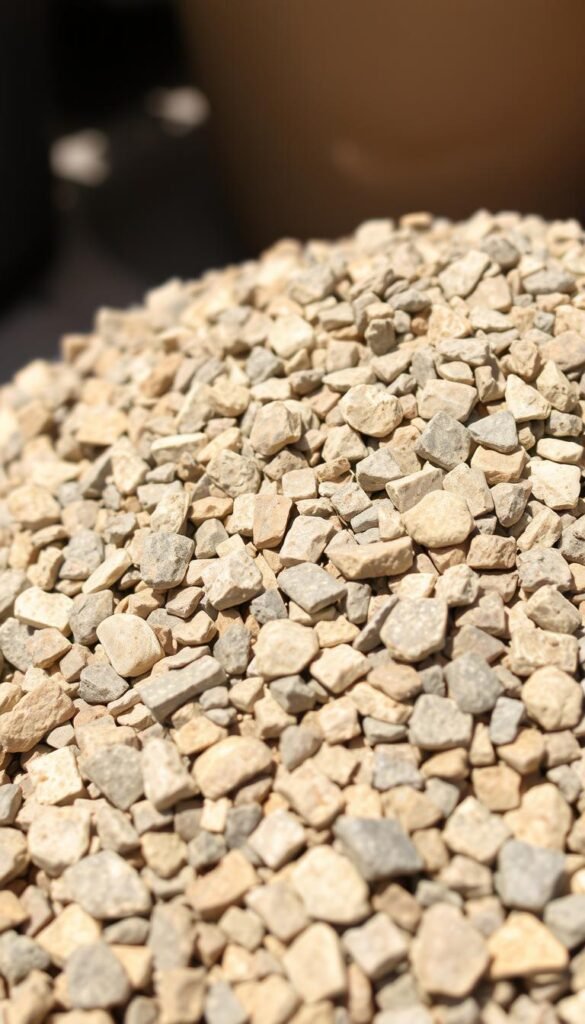
Dense, compacted earth can suffocate roots—unless you add the right mineral helper. Potting grit, a crushed stone blend, creates permanent air channels. Unlike sand, it won’t wash away or compact over time.
Grain Size Comparisons for Different Crops
Match grit size to your plants’ needs. Carrots thrive with 3–5mm particles, while herbs like lavender prefer finer 1–2mm grades. Granite grit slightly acidifies soil, ideal for blueberries. Limestone versions suit alkaline-loving crops.
| Crop | Grit Size | Material |
|---|---|---|
| Root vegetables | 3–5mm | Granite |
| Herbs (rosemary, lavender) | 1–2mm | Limestone |
| Seedlings | 1mm | Quartz |
Creating Permanent Aeration Channels
Mix 15% grit into your raised bed blend. This ratio balances drainage and moisture retention. For existing beds, use a broadfork to work grit 12″ deep—it’s like giving roots a subway system.
“Grit’s capillary action pulls water upward, preventing soggy roots while hydrating plants.”
Avoid builder’s sand—it lacks pore space. Bulk grit costs ~$0.50/lb, cheaper than store bags. For heavy clay, combine grit with compost to boost structure and root growth.
Leaf Mold: Nature’s Free Amendment
Turn fallen leaves into garden gold with this natural soil enhancer. Leaf mold—decomposed leaves—boosts water retention by 70% and adds crumbly texture. Best of all, it’s free and easy to make.
Accelerating decomposition with simple techniques
Shred leaves with a mower or mulcher to speed breakdown. Whole leaves take 2 years to decompose; shredded pieces turn to mold in 6–12 months.
Try these methods:
- Bin method: Layer leaves with grass clippings (3:1 ratio) in a wire cage. Turn monthly.
- Bag method: Fill garbage bags with damp leaves, poke holes, and stash in shade.
“Oak and maple leaves break down slower but offer higher organic matter. Avoid walnut—it’s toxic to plants.”
| Leaf Type | C:N Ratio | Decomposition Time |
|---|---|---|
| Maple | 50:1 | 12–18 months |
| Oak | 60:1 | 18–24 months |
| Pine needles | 80:1 | 24+ months |
Using leaf mold as mulch and amendment
Sift finished mold through ½-inch mesh for a fine texture. Spread 2–3 inches as mulch to lock in moisture and suppress weeds.
Top crops for leaf mold:
- Brassicas (kale, cabbage)
- Root vegetables (carrots, beets)
- Berries (blueberries, strawberries)
Urban foraging tip: Collect untreated leaves from parks—avoid roadsides with pollution. Thirty bags of leaves make 1 cubic yard of mold.
Boost plants further with leaf mold tea: Steep 1 cup mold in 1 gallon water for 48 hours. Strain and pour around roots for a gentle nutrient kick.
Biochar: The Carbon-Rich Soil Booster
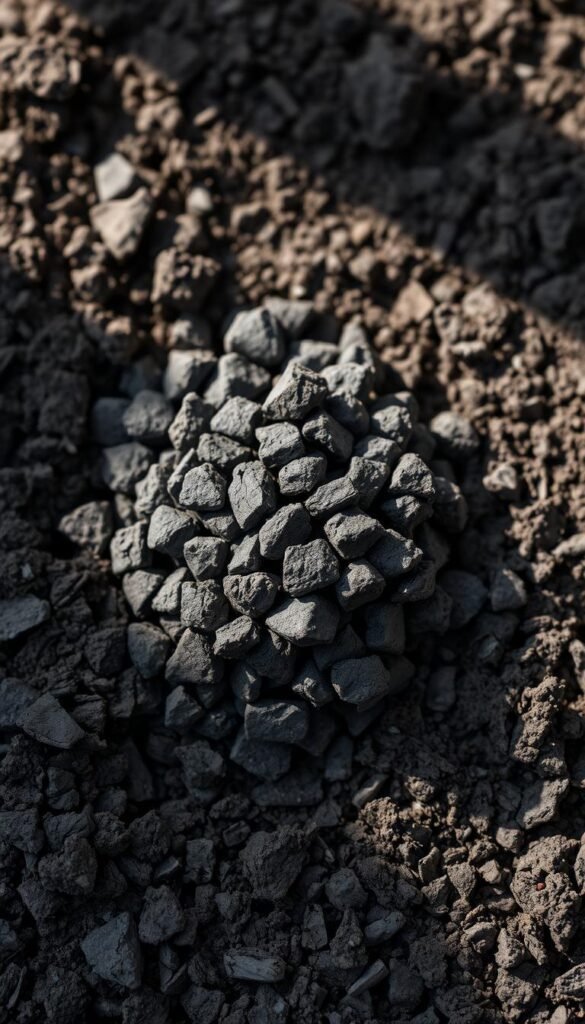
Ancient Amazonian secrets meet modern gardening with this powerful soil enhancer. Biochar—a charcoal-like substance—traps nutrients and water while locking away carbon. Studies show it can increase yields by 10% while improving long-term soil health.
Making biochar at home safely
Pyrolysis (heating organic matter without oxygen) creates biochar at 500°C. Two DIY methods work well:
- Barrel method: Use a 55-gallon drum with ventilation holes. Burns cleaner but requires monitoring.
- Pit method: Dig a cone-shaped pit for traditional kiln-style burning. More smoke but higher yields.
“Always keep a fire extinguisher nearby—biochar production involves open flames.”
| Method | Temperature | Yield | Safety Tip |
|---|---|---|---|
| Barrel | 400–600°C | 30% input weight | Use grill thermometer |
| Pit | 300–500°C | 25% input weight | Clear 10-foot radius |
Activating your biochar
Raw biochar steals nitrogen as it breaks down. “Charge” it first by soaking in compost tea for 48 hours. This loads it with nutrients and microbes.
Best application rates:
- 5–10% by volume for new beds
- 1-inch layer topped with compost for existing gardens
For acidic soils, rinse biochar with vinegar water (1 cup per gallon) before charging. Tomatoes and peppers show the strongest response—one grower reported 25% better drought resistance.
When to Amend Your Raised Bed Soil
Timing is everything when enriching your garden’s foundation—get it right for explosive growth. The best soil amendments work wonders only when applied at the right time. Sync your schedule with plant needs and seasonal shifts.
Pre-planting preparations for spring
Start 6–8 weeks before your last frost date. This gives amendments like compost time to integrate. Test soil temperature—it should hit 50°F for most crops.
Priority tasks:
- Mix in 2 inches of compost for nutrients.
- Add vermiculite if drainage is poor.
- Avoid fresh manure; it can burn young roots.
Mid-season nutrient boost timing
Replenish soils halfway through the growing season. Heavy feeders like tomatoes need extra support. Top-dress with compost tea or worm castings every 3–4 weeks.
“Late-summer crops benefit from a July refresh—think cucumbers and beans.”
Fall soil rebuilding strategies
Post-harvest is prime time for major upgrades. Follow this fall soil prep guide to rebuild structure:
| Task | Benefit |
|---|---|
| Add biochar | Locks in nutrients for spring |
| Plant cover crops | Prevents erosion, adds nitrogen |
Skip high-nitrogen feeds in fall—they spur tender growth vulnerable to frost.
How to Test Your Soil Before Amending
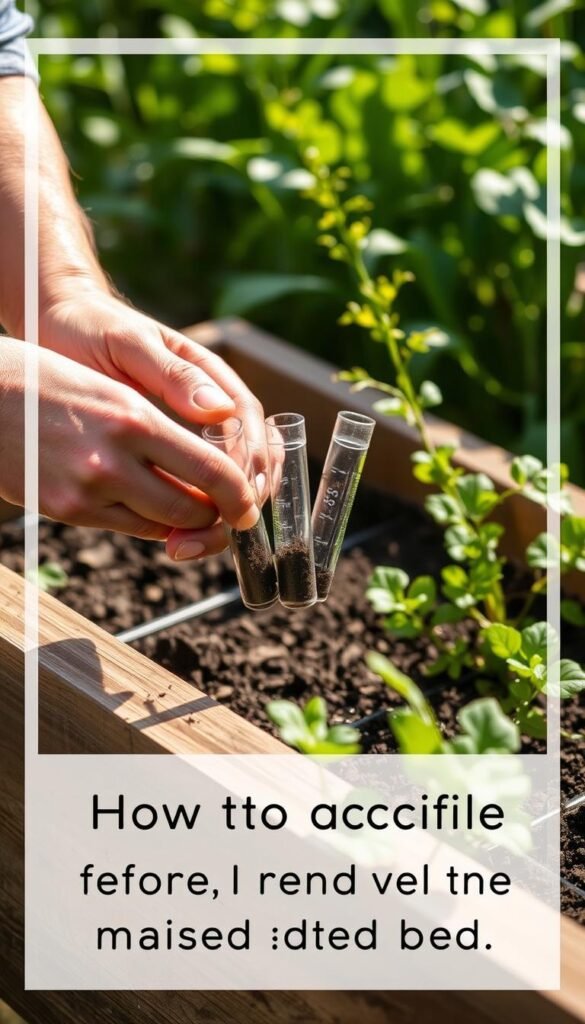
Smart gardeners never guess—they test. Knowing your soil test results prevents wasted effort and ensures plants get what they need. Whether you use DIY tricks or lab kits, accurate data guides your amendment choices.
DIY pH test methods
Two simple home methods reveal acidity levels. The vinegar/baking soda test works fast:
- Collect samples from 4-6 spots in your garden (6″ deep).
- Mix with distilled water to make mud.
- Split into two containers.
Add vinegar to one—fizz means alkaline (pH 7+). Baking soda in the other bubbles if acidic (below 7). For more precision, try pH strips ($5-10). Dip them in soil slurry and match colors to the chart.
“Home tests show trends, not exact numbers. For crops like blueberries needing pH 4.5-5.5, invest in a digital meter.”
Reading commercial test kit results
Kits like Rapitest ($15-30) measure NPK and pH. Here’s how to interpret them:
| Reading | Ideal Range | Action |
|---|---|---|
| pH | 6.0-7.0 | Add lime (raise) or sulfur (lower) |
| Nitrogen (N) | 20-40 ppm | Compost or manure if low |
| Phosphorus (P) | 30-50 ppm | Bone meal for deficits |
Avoid testing right after adding amendments—wait 2-3 weeks. For deeper insights, check your local extension service’s lab. Their $25-50 tests include CEC (cation exchange capacity) and micronutrients.
Pro tip: Mycorrhizal tests ($12 add-on) show beneficial fungi levels. High counts mean better nutrient uptake—especially in raised beds where roots need help.
Mixing Amendments Like a Pro
Mastering the blend of organic and mineral additives unlocks your garden’s true potential. The right technique ensures even distribution of nutrients while preserving air pockets roots need.
The 1-1-1 formula breakdown
This gold standard blend combines equal parts:
- Compost (organic matter)
- Topsoil (mineral base)
- Aeration material (vermiculite or perlite)
Measure by volume, not weight—one wheelbarrow of each creates 3 cubic feet. For precision:
| Amendment | Volume | Weight Equivalent |
|---|---|---|
| Compost | 1 gallon | 4–6 lbs |
| Topsoil | 1 gallon | 12–14 lbs |
| Vermiculite | 1 gallon | 0.5–1 lb |
“Double-digging—loosening soil to 24 inches—improves mixing depth by 300% compared to tilling.”
Layering vs. thorough mixing techniques
Lasagna layering works best for no-dig beds. Alternate 2-inch compost and topsoil layers, topping with aeration material. This mimics forest floor decomposition.
For new raised beds, full mixing creates uniform structure. Use a hoe or broadfork to blend amendments 12 inches deep. Over-mixing destroys clumps that hold air—stop when ingredients are evenly distributed.
Pro tips:
- Moisten dry amendments before mixing to reduce dust
- Wear an N95 mask when handling biochar or vermiculite
- Mark handles with depth notches (6″, 12″, 18″)
| Method | Best For | Yield Increase |
|---|---|---|
| Layering | Established beds | 15% (Year 1) |
| Full mixing | New installations | 35% (Year 1) |
A Michigan gardener documented 80% higher tomato yields after switching to thorough mixing. Their secret? Adding biochar at 5% volume during initial blending.
Seasonal Amendment Rotations
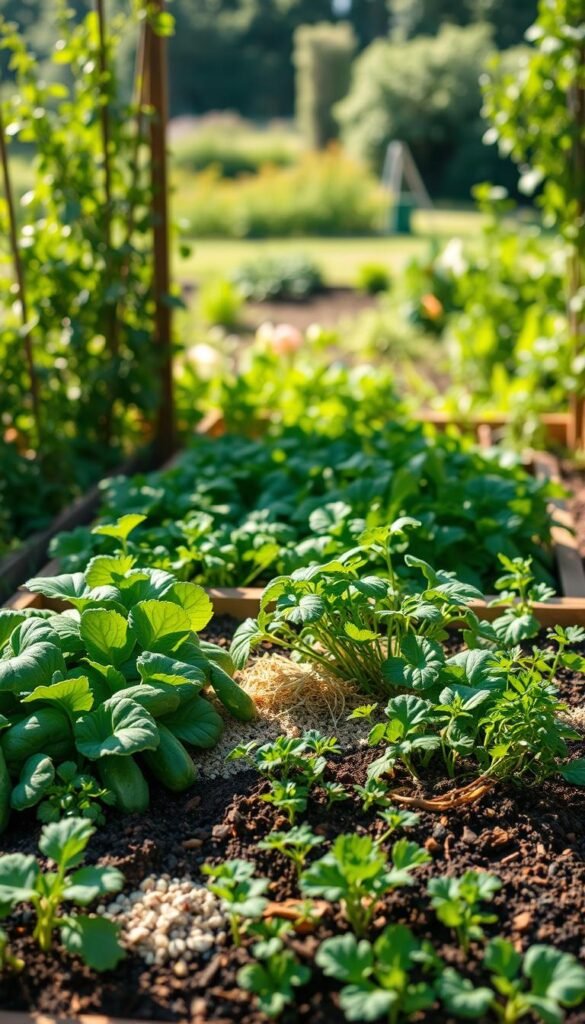
Your garden’s needs change with the seasons—adapt your amendments accordingly. Cool-weather crops crave different nutrients than summer producers. Strategic timing can boost yields by 15-20% while preventing waste.
Spring priorities for early growth
Focus on quick-release nitrogen for leafy greens and brassicas. These crops need:
- Compost tea (every 2 weeks)
- Blood meal for fast nitrogen
- Worm castings for gentle feeding
Nightshades (tomatoes, peppers) prefer phosphorus-heavy mixes. Wait until soil hits 60°F to add bone meal. One urban gardener doubled harvests by splitting applications—half at planting, half at flowering.
“Spring amendments should work fast—think 2-3 week breakdown times for cool-season crops.”
Fall rebuilding for future seasons
Autumn is for slow-release improvements in your raised bed. Top tasks:
- Mix in biochar (stores nutrients over winter)
- Add potassium-rich wood ash
- Layer leaf mold as insulation
Store leftover amendments in airtight bins. Keep manure separate from other organics to prevent cross-contamination. Lime should never be applied in summer—it burns roots during heat waves.
| Crop Family | Year 1 Amendments | Year 2 Amendments | Year 3 Amendments |
|---|---|---|---|
| Brassicas | Compost + blood meal | Biochar + kelp meal | Manure + greensand |
| Nightshades | Bone meal + compost | Worm castings + gypsum | Fish meal + perlite |
| Legumes | Wood ash + compost | Leaf mold + basalt dust | Biochar + alfalfa meal |
Urban gardeners can follow this monthly checklist:
- March: Test soil, add compost
- June: Side-dress heavy feeders
- September: Sow cover crops
- December: Apply mulch blanket
Match your garden care to nature’s rhythm. Plants will reward you with abundant harvests year after year.
Common Soil Amendment Mistakes to Avoid
Even experienced gardeners can stumble when enriching their growing space—here’s how to sidestep common errors. While amendments boost soil health, missteps can undo months of work. A 5-year USDA study found improper practices cause 40% yield losses in raised beds.
The hidden costs of over-amending
More isn’t better. Excess fertilizers create salt buildup, measurable with an EC meter (target 1-4 mS/cm). Symptoms include:
- Leaf burn at edges
- Stunted growth despite dark green color
- White crust on soil surface
“Uncharged biochar acts like a sponge—it’ll steal nitrogen if not pre-soaked in compost tea for 48 hours.”
Dangerous amendment combinations
Some mixes harm plants or waste nutrients. Avoid these pairs:
| Combination | Effect |
|---|---|
| Manure + lime | Releases ammonia gas |
| Fresh sawdust + seeds | Ties up nitrogen for 6+ months |
Municipal compost may contain herbicides—test a small area first. For “hot” soils (pH >7.5), sulfur takes 3-6 months to work. Plan ahead to avoid planting time delays.
Pro tip: Annual soil tests prevent guesswork. One gardener corrected copper toxicity over 3 years by tracking changes—her peppers now produce 70% more fruit.
Budget-Friendly Amendment Alternatives
Your garden doesn’t need expensive products to thrive—nature provides plenty of free resources. With a little time and creativity, you can build rich organic matter without breaking the bank. Studies show these methods can save up to 60% on raised beds costs.
Kitchen scrap composting
Turn food waste into black gold with these simple systems:
- 5-gallon bucket method: Drill holes in a bucket, layer scraps with leaves, and stir weekly. Ready in 3 months.
- Bokashi fermentation: Anaerobic composting with bran microbes. Works for meat/dairy—just bury after 2 weeks.
- Free coffee grounds: Starbucks and local cafes often give these away. They add nitrogen and improve texture.
“Eggshells add calcium, but crush them first. Whole shells take years to break down.”
Community resource harvesting
Tap into these free or low-cost garden boosters:
| Resource | Where to Find | Tip |
|---|---|---|
| Leaf mold | Park cleanups | Avoid roadsides (pollution risk) |
| Wood chips | Tree services | Request untreated hardwood |
| Grass clippings | Neighbors | Verify no herbicides were used |
Local programs often offer:
- Free municipal compost (call your waste department)
- Tool rentals at libraries
- Community compost agreements (share bins with neighbors)
Pro tip: Partner with restaurants for veggie scraps—many will save them if you provide a bin. One urban gardener fed 10 raised beds entirely with recycled amendments.
Maintaining Soil Health Between Amendments
Keeping your garden productive year after year requires smart strategies between feedings. While compost and minerals provide immediate boosts, long-term soil health depends on what happens between applications.
Crop rotation planning
A 4-year rotation cycle prevents nutrient depletion and pest buildup. Divide your raised beds into four sections, rotating plant families annually:
- Year 1: Heavy feeders (tomatoes, corn)
- Year 2: Legumes (beans, peas) to fix nitrogen
- Year 3: Light feeders (lettuce, herbs)
- Year 4: Soil builders (cover crops)
Marigolds and mustard greens naturally suppress nematodes. Plant them before susceptible crops like carrots or potatoes. This maintenance trick can reduce pest damage by 60%.
Cover cropping for raised beds
When beds sit empty, cover crops protect and enrich the earth. Clover adds nitrogen while winter rye prevents erosion. For small spaces, try low-profile options like:
- Crimson clover (12″ tall)
- Buckwheat (18-24″)
- Annual ryegrass (6-12″)
“Winter rye should be terminated when 12-18″ tall—mow it down, then till lightly before planting.”
The chop-and-drop method saves work. Simply cut plants at soil level and leave them as mulch. This returns nutrients while suppressing weeds.
| Season | Cover Crop | Benefit |
|---|---|---|
| Spring | Field peas | Fast nitrogen fixation |
| Summer | Buckwheat | Phosphorus mobilization |
| Fall/Winter | Rye + vetch | Erosion control |
Never leave beds bare—even in winter. A 3-inch mulch layer regulates temperature and moisture. For year-round care, follow this raised bed guide to build proper maintenance into your routine.
Pollinator blends like clover-phacelia mixes support bees while improving soil. Biochar’s benefits last 3-5 years, making it ideal for long-term planting areas. With these strategies, your garden stays vibrant between major improvements.
Sustainable Soil Practices for Years of Abundance
Building lasting fertility means thinking beyond single-season fixes. A 5-year plan with biochar and compost cycles can increase yields by 200-400%, studies show. Start small—add 5% biochar yearly to lock in nutrients while reducing carbon footprints.
Closed-loop systems turn waste into wealth. Urban farms like Detroit’s Recovery Park reuse 90% of their organic matter. Try composting kitchen scraps with leaf mold to create free, sustainable amendments.
Teach kids to test earth with vinegar-baking soda experiments. This sparks lifelong garden stewardship. Avoid synthetic shortcuts—they degrade soil health over time.
Take the pledge today: Test your raised beds annually and share results with a gardening friend. Healthy earth grows generosity alongside food.

